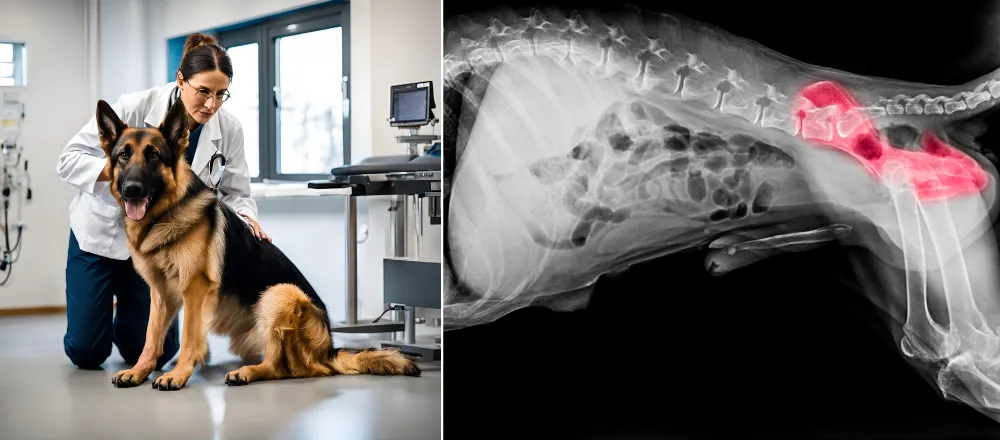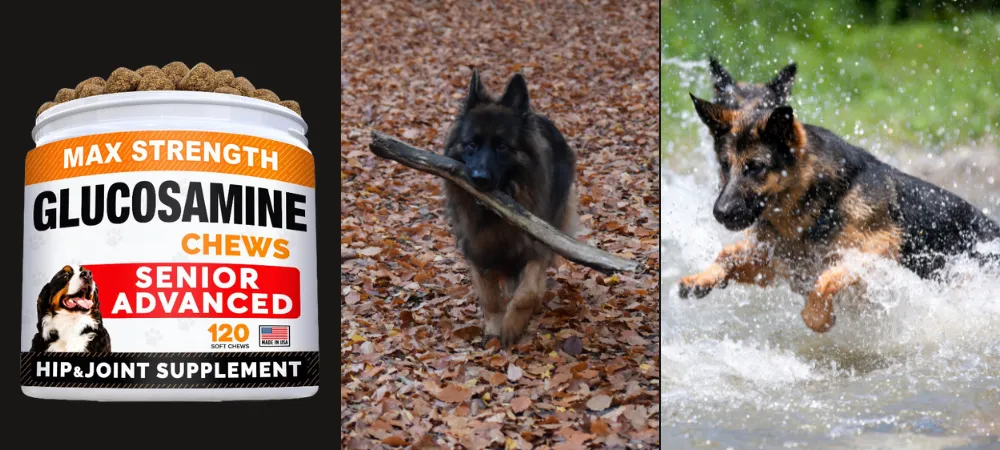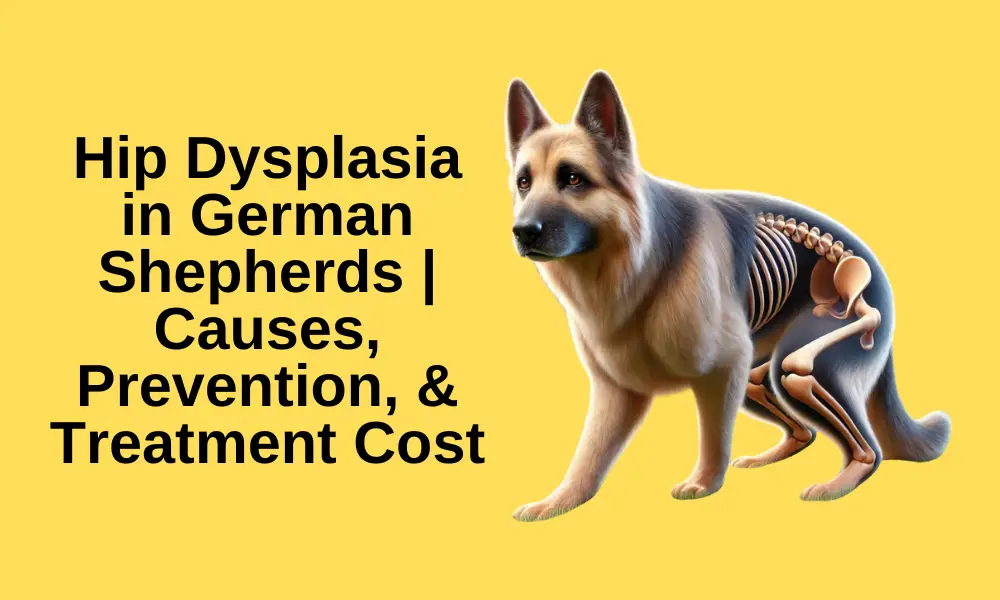Do you want to know what is hip dysplasia in dogs, how it affects German Shepherds, its causes, prevention, and treatment costs? You’re in the right place.
Hip dysplasia in dogs is a genetic orthopedic condition affecting their hip joint, where the ball (femoral head) and socket (acetabulum) fail to fit snugly together. This misalignment leads to joint instability, resulting in abnormal wear, inflammation, pain, and eventual arthritis.
While commonly associated with large-breed dogs, hip dysplasia can affect any dog, irrespective of size. The condition is progressive, meaning it worsens over time if not managed properly.
The following topics will be covered in this post:
- Dog Breeds Most Affected by Hip Dysplasia
- At What Age Can Hip Dysplasia Occur in German Shepherds?
- Main Causes of Hip Dysplasia in German Shepherds
- How to Predict Hip Dysplasia in German Shepherds
- How to Prevent Hip Dysplasia in German Shepherds
- Cost of Hip Dysplasia Treatment
RELATED
- Common German Shepherd Health Myths Debunked
- German Shepherd Teeth Problems: Causes, Prevention, Treatment
- Degenerative Myelopathy in German Shepherds | Causes & Prevention
- Role of German Shepherds in Therapy & Emotional Support
- Training German Shepherds for Families With Young Children
- Breeding Frequency for Male German Shepherds
- Best Way to Take German Shepherd for Walk: A Complete Guide
- Monthly & Annual Expenses of Owning a German Shepherd
|| DON’T MISS! Today’s Deals on Chewy – Pet Foods, Products, Supplies, Toys and more…
01. Dog Breeds Most Affected by Hip Dysplasia
Here’s a table of dog breeds most affected by hip dysplasia to date with approximate prevalence percentages based on recent studies and data:
| Rank | Breed | Percentage Affected | Remarks |
|---|---|---|---|
| 1 | English Bulldog | ~70% | Most affected due to structural abnormalities and genetics. |
| 2 | Pug | ~63% | High prevalence despite being a smaller breed; linked to skeletal structure. |
| 3 | Saint Bernard | ~49% | Giant breed; rapid growth and heavy size increase risk. |
| 4 | Neapolitan Mastiff | ~48% | Large, heavy bones put stress on joints. |
| 5 | French Bulldog | ~46% | Compact build contributes to joint issues. |
| 6 | Newfoundland | ~43% | Giant breed with a genetic predisposition. |
| 7 | Rottweiler | ~41% | Muscle mass and heavy weight stress hip joints. |
| 8 | Bernese Mountain Dog | ~39% | Heavy, large breed with hereditary risk. |
| 9 | German Shepherd | ~19% | Structural issues remain, but selective breeding has helped lower rates. |
| 10 | Golden Retriever | ~20% | Rates are lower due to improved breeding practices. |
| 11 | Labrador Retriever | ~13% | Commonly affected but less than some other breeds due to health screening. |
Key Points:
- Bulldogs (English & French): Top the list due to their physical conformation.
- Giant Breeds: Rapid growth and body weight exacerbate the condition (e.g., Saint Bernard, Newfoundland).
- Improvement Through Breeding: Some breeds (e.g., Labradors, German Shepherds) have seen decreased prevalence due to selective and careful breeding.
02. At What Age Can Hip Dysplasia Occur in German Shepherds?
Hip dysplasia can begin in puppies as young as 4-6 months old, though symptoms may not appear until the dog matures or becomes more active. In some cases, signs become evident only in later adulthood, especially if arthritis develops.
Arthritis in dogs is a chronic condition characterized by inflammation and degeneration of the joints, leading to pain and stiffness. It commonly affects older dogs but can also occur due to injury, obesity, or genetic predispositions. Symptoms include difficulty moving, limping, and reduced activity levels.
03. Main Causes of Hip Dysplasia in German Shepherds
Below are some of the main causes of hip dysplasia in German Shepherds:
- The condition is hereditary, often passed down from one or both parents.
- Accelerated skeletal growth in puppies can stress the hip joints.
- Overfeeding or high-calorie diets can lead to rapid weight gain, which exacerbates joint stress.
- Excessive weight places undue pressure on developing or aging hip joints.
- Hard flooring, overexertion, or lack of exercise during puppyhood can negatively influence hip joint development.
04. How to Predict Hip Dysplasia in German Shepherds
Below are some symptoms that you can watch for and predict hip dysplasia in German Shepherds:
- Difficulty Standing or Rising: Struggling to get up, especially after resting.
- Decreased Activity Levels: Reluctance to run, jump, or climb stairs.
- Limping or Lameness: Favoring one or both hind legs.
- Swaying or Bunny-Hopping Gait: A wobbly walk or hopping motion with the back legs.
- Pain or Sensitivity: Whining or flinching when hips are touched or during movement.
- Muscle Loss in Hindquarters: Noticeable thinning of the back leg muscles.

Diagnosis Methods:
These are some diagnosis methods for determining hip dysplasia in German Shepherds:
- Physical Examination: Veterinarians may assess joint looseness or range of motion.
- X-rays: A definitive diagnostic tool for determining hip joint conformation.
- Genetic Screening: Genetic screening is the process of analyzing an individual’s DNA to identify specific genes or mutations associated with diseases or traits. It helps predict the risk of inherited conditions and guides informed decisions in healthcare or breeding. Responsible breeders use this testing to select mating pairs, reducing the prevalence of hip dysplasia in future generations.

05. How to Prevent Hip Dysplasia in German Shepherds
Below are some of the ways to prevent hip dysplasia in German Shepherds:
- Buy dogs and puppies from responsible breeders who screen their breeding dogs for hip dysplasia using OFA or PennHIP certifications.
- Maintain a healthy weight. Keep your dog lean to reduce stress on the hip joints.
- Provide moderate, low-impact exercises like swimming or walking to strengthen muscles without overstraining joints.
- Feed a balanced diet suitable for large-breed puppies, avoiding excess calcium or high-calorie foods.
- Providing joint supplements like glucosamine, chondroitin, and omega-3 fatty acids can support joint health.
- Conduct regular vet checkups. Early detection allows for timely intervention.

06. Cost of Hip Dysplasia Treatment
The cost of treating hip dysplasia can vary widely depending on the severity, and treatment method:
| Treatment Option | Cost Range | Details |
|---|---|---|
| Weight Management & Supplements | $200–$500 annually | Includes joint supplements and dietary adjustments. |
| Physical Therapy | $50–$100 per session | Regular sessions help improve mobility and reduce pain. |
| Pain Medication | $30–$100 per month | For managing chronic pain. |
| Surgery: FHO (Femoral Head Osteotomy) | $1,200–$3,000 per hip | Removes the femoral head to alleviate pain. |
| Surgery: TPO (Triple Pelvic Osteotomy) | $3,000–$5,000 per hip | For young dogs with minimal arthritis. |
| Surgery: Total Hip Replacement | $4,000–$7,000 per hip | Gold-standard treatment for severe cases. |
Conclusion
Hip dysplasia in German Shepherds is a manageable condition with proper care, early detection, and preventive measures. Regular vet visits, maintaining a healthy lifestyle, and selecting responsible breeders are vital in mitigating the risks. For dogs already affected, a combination of medical management, lifestyle adjustments, and, if necessary, surgical intervention can significantly enhance their quality of life.
If you like this post then don’t forget to share with other people. Share your feedback in the comments section below.
Also Read
- What are Challenges of Training & Raising German Shepherd?
- What is the Average Intelligence of German Shepherds?
- What Health Products Should Every German Shepherd Owner Have?
- How to Know German Shepherd Breeder is Genuine?
- German Shepherd Energy Levels by Age | Activity Needs
- How Does Selective Breeding Affect Dog’s Appearance
- How to Extend the Lifespan of German Shepherd




Leave a Reply